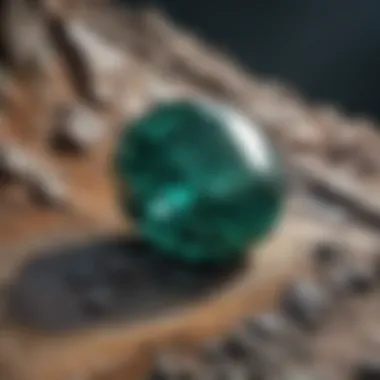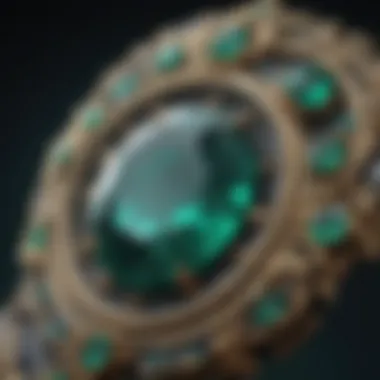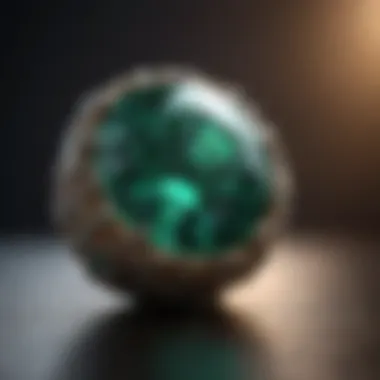Emerald Pricing: Factors and Insights


Intro
Emeralds have captivated humans for centuries, representing not just beauty but also value and prestige. The pricing of emeralds is a multifaceted issue influenced by various factors that require a thorough understanding. This article aims to dissect these factors, offering insights into pricing dynamics that can help collectors, enthusiasts, and investors make informed decisions.
Overview of Emerald Pricing
Emerald pricing is a multifaceted subject that merits in-depth exploration. Understanding how the emerald market operates helps collectors, jewelry designers, and enthusiasts make informed decisions. Emeralds are amongst the most sought-after gemstones, boasting a rich history and significance in various cultures. Pricing is not solely a reflection of the stone's beauty; it is an intricate interplay of quality, origin, demand, and market trends. Accurate comprehension of these elements can lead to better purchasing choices.
What Defines Emerald Price
The price of an emerald is defined by several critical factors. Primary among these are the quality attributes, including color, clarity, cut, and carat weight.
- Color: The color of an emerald is vital in determining its value. Ideal emeralds showcase a deep green hue, with purity and vibrant saturation contributing significantly to their appeal and pricing.
- Clarity: Clarity refers to the presence of inclusions and blemishes within the gemstone. Higher clarity generally correlates with higher value, as gems with fewer inclusions are often perceived as more desirable.
- Cut: The cut affects the stone's overall aesthetic appeal. A well-cut emerald will reflect light better and showcase its color more vividly.
- Carat Weight: Size does matter in the world of gemstones. Larger stones are typically rarer and thus command higher prices, though this must be considered alongside quality attributes.
Beyond these elements, the geographic origin also plays a crucial role in pricing. For instance, Colombian emeralds are often considered the gold standard, prized for their unparalleled quality and rich color.
Emerald Price Per Gram Explained
Emerald pricing is frequently discussed in terms of price per gram. This metric can provide valuable insights into the market's valuation of emeralds, enabling buyers to evaluate gemstones more accurately.
To understand this, consider the following:
- Market Fluctuation: Prices can fluctuate based on demand, supply, and prevailing market conditions. Economic factors such as inflation and consumer trends also influence these dynamics.
- Comparable Analysis: Buyers can compare price per gram across different sources, both online and offline, to assess the prevailing market rate.
- Value for Money: By understanding the price per gram, purchasers can evaluate whether they are getting good value based on the quality and attributes of a specific stone.
This pricing model helps not only in better negotiation but also in fostering confidence during purchases. It turns the often ambiguous world of gemstones into a more structured and comprehensible landscape for buyers.
Understanding the price per gram model demystifies emerald values and leads to more informed purchases.
Factors Influencing Emerald Prices
Understanding the factors that influence emerald prices is essential for anyone looking to invest in or purchase emerald jewelry. Various elements contribute to the final cost, including quality attributes, geographic origin, market demand, and the influence of collectors. Collectively, these aspects help to create a hierarchy of value in the emerald marketplace. By grasping these factors, consumers can make more informed decisions and engage more meaningfully with the emerald market.
Quality Attributes
Emeralds possess distinct quality attributes, where factors such as color, clarity, cut, and carat weight directly correlate with their market value. These attributes not only define the overall look and appeal but also significantly affect the gem's pricing. Let's delve into each attribute to understand its nuances:
Color
Color stands as one of the most critical aspects of emerald pricing. The most sought-after emeralds exhibit a vivid, rich green hue, often described as having a bluish tint. The intensity and saturation of this color contribute substantially to the gem's desirability and price. A cleaner, vibrant green means higher value. However, too much blue or yellow can detract from the gem's worth. The balance that produces the ideally colored emerald is a defining characteristic that makes it a popular choice for collectors and investors alike.
Clarity


Clarity refers to the presence of inclusions or blemishes in an emerald. Unlike diamonds, emeralds often contain natural inclusions known as 'jardin,' which adds character to the stone. While some inclusions are acceptable, reflecting the gem's natural origins, a higher clarity rating typically results in a more valuable gemstone. This presents a unique challenge; while some buyers appreciate the uniqueness of inclusions, others may focus on clarity as a primary concern.
Cut
The cut of an emerald affects not just its aesthetic appeal but also how it interacts with light. An expertly cut emerald will maximize its sparkle and clarity, enhancing its overall appearance. The traditional step cut is popular as it reveals the stone's color beautifully. Different cuts can either elevate or diminish the value, depending on how well they complement the stone's inherent qualities. Buyers should consider how the cut influences the emerald's visual properties and market price.
Carat Weight
Carat weight represents the size of the emerald and is traditionally a straightforward measure of value. Larger stones generally command higher prices; however, quality attributes such as color and clarity can shift this dynamic. A smaller, flawless, or vivid emerald may surpass a larger, lower-quality stone in terms of price. Therefore, carat weight acts as one of the key but not sole determinants of value. Individual buyers should weigh size against quality when evaluating options.
Geographic Origin
The geographic origin of an emerald significantly contributes to its identity and value. Origins can vary widely, with specific sources developing reputations for distinct qualities. Colombian, Zambian, and Brazilian emeralds each feature unique characteristics that often attract different levels of demand.
Colombian Emeralds
Colombian emeralds are perhaps the most acclaimed and sought-after in the market. Renowned for their exceptional color and clarity, these emeralds often fetch the highest prices. Their warm, deep green shades paired with minimal inclusions make them a premium choice. However, high demand can also drive prices upwards, leaving potential buyers with a limited understanding and options.
Zambian Emeralds
Zambian emeralds are known for their slightly darker tone, often presenting a rich, lush green highly desired among gem enthusiasts. They often display good clarity while being more affordable than their Colombian counterparts. As the market grows, Zambian emeralds are increasingly recognized for their value, offering quality options without the Colombian price tag.
Brazilian Emeralds
Brazilian emeralds, while not holding the same prestige, present unique characteristics that some collectors find intriguing. Their colors may range from lighter greens to yellowish shades. Prices can vary widely based on clarity and cut. Understanding the features of Brazilian emeralds helps buyers make balanced decisions when considering their investment.
Market Demand and Supply
Market demand and supply play a critical role in determining emerald prices. Economic conditions, trends in jewelry preferences, and consumer interests shape the essence of supply chains. In moments of heightened demand, prices can surge quickly. Conversely, if the supply exceeds demand, prices may decline. Understanding these market dynamics helps consumers gauge the right moments for purchasing emeralds.
Influence of Collectors
Collectors significantly impact emerald pricing. Their willingness to pay premium prices for high-quality or rare stones tends to drive overall market values. Additionally, trends among collectors can shift suddenly, caused by a desire for particular origins or qualities. Monitoring collector behavior helps potential buyers predict price movements and make savvy purchases.
Emerald Grading Systems
Emerald grading systems are crucial in establishing the value and authenticity of emeralds in the gemstone market. The process of grading not only helps consumers understand the quality of what they are purchasing but also assists jewelers and collectors in making informed decisions. This system provides a standardized framework for evaluating essential characteristics, thus playing an integral role in price determination.
Understanding the Grading Scale
Emeralds are graded based on various attributes. The most recognized scale evaluates four primary characteristics:
- Color: This is the most significant factor. The finest emeralds possess a rich, vivid green hue, often with slight blue undertones. The intensity and tone of the color can greatly influence price.
- Clarity: Unlike diamonds, some inclusions in emeralds are tolerated. However, more clarity means higher value. Emeralds with fewer inclusions are rarer and command higher prices.
- Cut: The way an emerald is cut affects its brilliance and exposure of color. Quality cuts enhance the visual appeal of the gemstone, thus adding to its value.
- Carat Weight: Larger emeralds usually mean higher prices per gram. However, size alone is not adequate to gauge value without considering other characteristics.


These qualities are typically marked on a scale from one to ten, where a higher score indicates better quality. Understanding this grading scale helps buyers discern the genuine value of emeralds.
The Role of Gemological Laboratories
Gemological laboratories are specialized institutions that provide detailed analysis and grading of gemstones. They employ advanced equipment and trained professionals to authenticate and assess each emerald's quality. These labs produce reports that outline the specific characteristics of each stone.
Buyers should consider that:
- Independent Verification: Reports from reputable gemological laboratories add authenticity and trust to any purchase. Only factories that adhere to strict ethical standards are considered trustworthy.
- Consistency: Having consistent grading standards ensures buyers know what they are getting. Transparency in the evaluation process fosters trust in the broader market.
- Value Assessment: A laboratory report facilitates comparisons between different stones, allowing potential buyers to make more informed decisions. It helps mitigate the risk of overpaying for inferior quality.
Certifications and Their Importance
Certifications play a pivotal role in the gemstone market. When an emerald comes with a certification, it attests to the quality and origin of the gemstone. This makes the buying process more straightforward for consumers.
- Documentation of Quality: Certifications provide formal assurance regarding the emerald’s grading, which is key for collectors and investors.
- Resale Value: An emerald with certification tends to maintain a higher resale value. Future buyers appreciate having documented evidence of a stone's quality.
- Market Trust: Certified emeralds contribute to a transparent market. They give consumers a reliable way to assess values without solely relying on seller claims.
Current Market Trends
Understanding current market trends is essential for anyone involved in the emerald industry, whether they are collectors, enthusiasts, or jewelers. The dynamics of emerald pricing fluctuate with ongoing changes in consumer preferences, global economics, and technological advancements. By staying attuned to these trends, buyers can make informed decisions that can maximize their investments while minimizing risks.
Emerald Market Behavior
Emeralds have shown distinctive pricing behaviors over recent years. The trends indicate volatility influenced by several factors. For instance, larger carat sizes are fetching significantly higher prices compared to smaller ones. The rarity of high-quality emeralds has also led to price inflation, especially in the luxury segments. These movements reveal an increasing tendency for consumers to prioritize quality over quantity. Moreover, auction results highlight a strong demand for exceptional stones, leading to considerable gains in overall market value.
Additionally, sourcing practices are evolving as the origin of the emerald plays a crucial role in pricing. Colombian emeralds, known for their superior color and clarity, often command higher prices. On the other side, Zambian and Brazilian emeralds are gaining traction due to their increasing quality and accessibility.
Emergence of Online Auctions
The rise of online auctions has transformed how emeralds are bought and sold. Platforms like eBay and specialized auction houses have expanded the marketplace, enabling buyers from around the globe to access a diverse range of emeralds. This trend not only increases competition but also drives prices upwards, as buyers are willing to bid more when they find exclusive pieces. The online environment offers transparency as sellers often provide detailed images and certificates of authenticity. This fosters trust, an important element in gemstone transactions.
The convenience of online bidding allows buyers to assess emeralds from their homes. This shift has empowered both small and large players in the market, offering opportunities for emerging collectors to find unique gems without geographical limitations.
Global Economic Impact
Emerald pricing does not exist in isolation. Global economic trends significantly influence pricing strategies and market behavior. For instance, during periods of economic growth, luxury items, including emeralds, often see increased demand. Collectors and investors are more willing to spend during these times, driving prices higher.
Conversely, in an economic downturn, the luxury market can face declines. Buyers may hesitate to purchase high-value items, leading to adjustments in pricing strategies across the board. Furthermore, geopolitical issues such as trade restrictions can also lead to fluctuations in the availability and price of emeralds.
"Economic conditions are like weather patterns for the gemstone market. They determine which stones are in demand and at what price."
In summary, understanding the current market trends, including emerald market behavior, the emergence of online auctions, and the broader global economic impact provides valuable insights for anyone looking to navigate the complexities of emerald pricing. Buyers who engage with these factors are better equipped to assess value and make strategic decisions in their emerald pursuits.
Consumer Guidance


In the intricate world of emerald pricing, consumer guidance emerges as a crucial component. This section aims to equip buyers, whether they are gemstone enthusiasts, collectors, or jewelry designers, with the knowledge necessary to navigate their purchasing decisions. Understanding how to identify quality emeralds, formulate effective pricing strategies, and avoid common pitfalls can lead to more informed and satisfying purchases.
The guidance provided here is not merely theoretical; it serves practical purposes. It helps potential buyers discern valuable gemstones from those that might merely appear attractive. Moreover, knowledge of effective strategies ensures that consumers do not overpay for their desired emeralds. By addressing common mistakes made during the purchasing process, this guidance seeks to minimize regret and enhance overall satisfaction.
Identifying Quality Emeralds
To successfully identify quality emeralds, one must consider several critical characteristics. The four key quality attributes—color, clarity, cut, and carat weight—play significant roles in determining an emerald’s value.
- Color: A rich, vibrant green is most sought after. Variations in hue can affect the perceived value, with the purest shades often commanding higher prices.
- Clarity: Emeralds often contain inclusions known as "jardin." While some inclusions are normal, fewer and less noticeable ones result in a higher-quality gemstone.
- Cut: The cut influences the stone's brilliance and overall aesthetic appeal. Emerald cuts, in particular, enhance the gem's color while minimizing the visibility of inclusions.
- Carat Weight: Heavier emeralds are rarer and generally more valuable, although the quality must complement the carat weight.
By paying close attention to these attributes, buyers can gain a clearer understanding of an emerald’s true value, ensuring that they invest in quality pieces.
Effective Pricing Strategies
Developing effective pricing strategies is essential for making informed purchases in the emerald market. Several tactics can enhance the purchasing process:
- Research: Understand current market prices by consulting reputable jewelers and online resources. Websites like Wikipedia and Britannica offer insights into historical data and current trends.
- Get Appraisals: Always seek evaluations from certified gemologists. Independent appraisals can confirm the legitimacy and value of a stone, preventing overpayment.
- Negotiate: Don't hesitate to negotiate prices with sellers. Many jewelers expect some level of bargaining, especially in high-value transactions.
- Buy during Off-Peak Times: Consider purchasing outside major holidays or peak shopping seasons when prices may be inflated due to demand.
Implementing these strategies effectively can lead to substantial savings and ensure that buyers make prudent choices.
Common Pitfalls in Emerald Purchasing
Many buyers fall victim to certain mistakes when purchasing emeralds. Being aware of these pitfalls can save considerable time and money:
- Neglecting Certification: Failing to check for certification from reputable gemological laboratories can lead to buying inferior stones disguised as high-quality gems.
- Overlooking Lighting Conditions: Examining emeralds under poor lighting can result in misjudging their color and clarity. Natural daylight is best for assessing these attributes accurately.
- Relying Solely on Appearance: Buyers sometimes make hasty decisions based on visual allure without consulting quality metrics and appraisals.
- Ignoring Return Policies: Purchasers may neglect to inquire about return or exchange policies. Knowing the terms beforehand can be crucial if the item does not meet expectations.
By understanding these common pitfalls, consumers can approach the emerald buying process with greater caution and confidence.
Always remember, informed purchasing is the key to satisfaction in the emerald market.
Closure
The discussion around emerald pricing encapsulates a multi-faceted understanding of the gem market. In this article, we explored various aspects that collectively shape and define the value of emeralds. One crucial element delved into was the future of emerald prices, where various factors such as market trends, demand, and economic indicators interplay. Taken together, these components can significantly influence what buyers and collectors can expect moving forward.
The Future of Emerald Prices
As the demand for gemstones continues to grow, emeralds stand out due to their unique beauty and rarity. Predictions about the future price of emeralds must account for several variables. First, advancements in technology could result in improved treatments that enhance the gem’s clarity and color, potentially affecting its market value. Additionally, sustainable mining practices may become more prevalent, supplying consumers with ethically-sourced emeralds that command higher prices.
Emerald prices may also be influenced by collectors’ preferences. For instance, certain origins will likely be favored over others. Colombian emeralds, known for their vivid green hues, may continue to lead the market. The broader economic landscape cannot be ignored either; fluctuations in disposable income can have direct effects on demand.
In summary, while trends may show variability, the perceived value of emeralds is likely to remain strong, albeit with cautious optimism based on economic conditions.
Final Thoughts on Purchasing Emeralds
When contemplating the purchase of emeralds, it is vital to approach the process with informed discretion. As mentioned throughout, one should prioritize quality attributes such as color, clarity, cut, and carat weight. Seeking certifications from trusted gemological laboratories provides assurance regarding the authenticity and quality of the emeralds being considered.
Price negotiation should reflect an understanding of current market trends and demand. Recognizing that not every emerald is valued equally empowers buyers to make wise decisions, avoiding common pitfalls that could lead to regrettable investments.
Ultimately, purchasing emeralds should not be a hasty endeavor. With thorough research, market awareness, and consideration of quality factors, buyers can navigate the emerald market effectively, securing pieces that not only hold aesthetic value but also financial significance over time.



